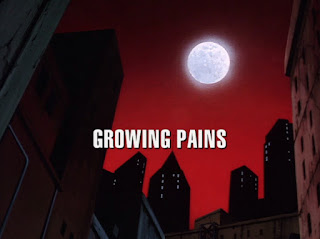 “What do you suppose they do on a date?”
“What do you suppose they do on a date?”Her reform efforts hindered by an unforgiving public, Mary Louise Dahl (Laraine Newman) watches the televised trial of Killer Croc (Brooks Gardner) and feels a pang of empathy for a man persecuted for his appearance. Donning her Baby-Doll regalia, she stages a breakout and retreats to the sewers with her new paramour. As they become Gotham’s Bonnie & Clyde, their crimes draw out Batman and Batgirl, while Croc’s uglier impulses start to overcome Baby-Doll’s more amorous ones.
As much as I didn’t enjoy “Baby-Doll” (clouding, recall, my memory of the quite decent third act), I’m not sure I’ve ever rewatched this episode. On the surface, it seems like this would put Baby-Doll at two for two in terms of dud episodes, but I found myself really digging “Love is a Croc” much more than I thought it was. It’s still somewhat off-putting and doesn’t quite sell me on Baby-Doll as a character, but writer Steve Gerber (who created Howard the Duck, among others) does well to take the focus away from Baby-Doll’s condition and emphasize instead that she’s a psychopath who just happens to be short. Her obsession with her appearance does, however, give her the unlikely yet narratively successful obsession with Croc, assuming he feels as she does – and missing, tragically, the fact that his “poor me” routine was a ploy for sympathy from the court.
Here’s an episode that works really well in isolation, but it crumbles a bit if we think about it in the larger context of the show. You’ve got Baby-Doll, who acquits herself rather well in this episode, but it’s tough to buy that she’s reformed to the point where she can manage a motel – particularly in Gotham, where rehabilitation seems to be a dirty word within the walls of Arkham. (Sidebar: how did Paul Dini never write an episode where Harley Quinn tries to adopt Baby-Doll, much to Poison Ivy’s incredulity?) Furthermore, Killer Croc’s brutish disinterest in his monstrous appearance is at direct odds with his role in “Sideshow,” where his embrace of monstrosity was tempered by his own sense of tragedy at the same. Here, Croc loses that depth and becomes uninterestingly thuggish, a dispiriting decline for a character who had one of the more surprising emotional arcs on the show.
In terms of the redesign, it’s a wash for this episode. Baby-Doll’s redesign is more angular and helpfully strips her of the Looney Tunes cuteness that saddled her character in her debut; Laraine Newman replaces Alison LaPlaca, but her voice is so close that I didn’t notice until the credits rolled. For Killer Croc, though, the redesign scraps his gray scales for a dark green and more reptilian appearance, but the shading on his green skin is so dark that he fades into the background in many scenes. Worse yet, Aron Kincaid has been replaced by Brooks Gardner, who doesn’t do anything interesting with Croc’s snarls or grunts. I’m sure that my attachment to Kincaid stems from his unmistakable delivery of the line, “I threw a rock at him!” (which I should hope is not unreasonable for anyone following this series), but for a Croc-centric episode, Gardner isn’t really bringing much to the table to replace the character-laden Kincaid. Gardner’s Croc does, however, seem to prefigure the “Pimp Croc” of the comic Broken City (which, in turn, inspired the Academy Award-winning Suicide Squad).
Robin and Nightwing are nowhere to be seen in this episode, giving time instead to the Batman/Batgirl team-up that has been a consistent selling point for The New Batman Adventures. In an episode as littered with sexual tension as this one, there’s an uncomfortable note in knowing that Bruce Timm has been guiding Batman and Batgirl together in a romantic way (which will always, until the end of time, be a gross misreading of the relationship, in every sense of the word “gross”). Granted, the Timmverse romance only gets as explicit as transparent flirtation in Mystery of the Batwoman – setting aside, as we all should, the first forty minutes of The Killing Joke – and thankfully here Batgirl plays the role of maturing teenager, joking about a villainous date night and maternally recommending a good spanking for Baby-Doll. It’s that spirit that has made Batgirl such an endearing member of the cast, and Tara Strong is doing definitive work in the role.
“Love is a Croc” is simultaneously the better Baby-Doll episode and the worst Killer Croc episode. It’s an odd story with a curious emotional center, defying resolution and sidelining its ostensible heroes in favor of an oddball romance between two misfit felons. But what else might we have expected from a writer who created a cigar-chomping pantsless duck? It’s rare for anyone to show up Paul Dini, but I almost think Gerber has gotten closer than anyone by halfway redeeming Baby-Doll.
Original Air Date: July 11, 1998
Writer: Steve Gerber
Director: Butch Lukic
Villains: Baby-Doll (Laraine Newman) and Killer Croc (Brooks Gardner)
Next episode: “Torch Song,” in which the star that burns brightest burns fastest.
🦇For the full list of The New Batman Adventures reviews, click here.🦇







